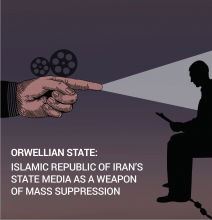奥威尔式国度:伊朗的强迫电视认罪与中国如出一辙
 强奸和处决威胁,鞭打,电击,眼皮底下折磨家人以及打掉牙齿等,这些只是伊朗强迫被拘留者在电视上认罪的其中一些方式。
强奸和处决威胁,鞭打,电击,眼皮底下折磨家人以及打掉牙齿等,这些只是伊朗强迫被拘留者在电视上认罪的其中一些方式。
以上内容出自非政府组织伊朗正义(Justice for Iran,以下简称JFI)的一份最新报告,该报告搜集了伊朗官方媒体播出强迫认罪的数据,并对13名受害者进行了采访,其中包括两名等待执行死刑的犯人,通过偷偷将手机带进他们牢房的方式完成采访。
该报告出台之际,正当中国环球电视网(CGTN)在英国被以广播强迫电视认罪裁定违法之时,电视监管机构Ofcom目前正在考虑将实施何种制裁:罚款还是吊销执照。[点此阅读相关文章]
JFI非政府组织在该伊朗报告《奥威尔式国度》(Orwellian State)中称,他们搜集了355名被拘留者的强迫电视认罪案例,这些人被迫在2009年至2019年之间,出现在伊朗伊斯兰共和国广播电视台(以下简称IRIB)和包括其英文台Press TV等子公司的151个节目中认罪。
被迫认罪的对象包括活动人士(包括从政治到劳工,儿童权利到环境等几乎所有层面),作家和新闻工作者,女性权利捍卫者,少数民族和宗教少数群体,双重国籍持有者和外国人。被指控的罪名包括与“外国势力”,恐怖主义,分裂主义和性行为不道德等有关。
该报告立即引起人们注意的是,伊朗的强迫认罪与中国的做法极为相似。
两个威权国家的一致做法包括:
- 通常在审判前,通过酷刑、威胁和说谎系统性地向被拘留者摘取供述;
- 针对视频设定脚本,策划和录制;
- 利用一些受害者在镜头中诽谤和抹黑其他人;
- 利用官方媒体及其海外频道播出认罪视频;
- 诋毁受害者与反对该政府的外国势力勾结;
- 录制和广播这些认罪视频,违反了有关正当程序和人权的本国和国际法律。
也有一些区别,最明显的两个是在伊朗案件中增加的宗教道德和威胁施用死刑(侮辱先知)。
我们2018年的报告《剧本和策划:中国强迫电视认罪的幕后》,可在此处阅读(向下滚动)。
以下是伊朗报告的主要内容,我们将其与中国进行了比较。
认罪视频并非一次性事件,而是系统性地录制和播出
电视认罪视频的广播数量很大。JFI搜集到过去11年间(2009-2019)伊朗播出了355个认罪视频,而保护卫士组织记录了2013年到2018年间中国官媒播出的涉及大约90人的电视认罪,可能还有更多未被发现的低调案例。两国采用提取和录制电视认罪的方法也极其相似,因此,也具有系统性。
播出电视认罪的主要媒体为国营媒体及其外语海外分支
两国都将其国营媒体渠道及其海外分支机构作为广播电视认罪主要平台。在伊朗,即为IRIB及其全球英文台Press TV。在中国,则是中央电视台(CCTV)及其全球英语频道CGTN和全球中文频道CCTV-4。
在报告中,JFI形容IRIB不再是一个媒体频道,而是一个 “大规模镇压的工具”。
两国的强迫认罪受害者均被视为当前政权的“敌人”
两国均将维权律师,活动人士,记者,少数民族(伊朗的库尔德人,阿拉伯人和土耳其人;中国的维吾尔族穆斯林)和外国人作为目标。在伊朗,性少数群体和非穆斯林也是目标。在中国,我们看到电视认罪中还包括一些被指控犯有普通金融犯罪的人。
为录制认罪视频,两国均采取酷刑和威胁相结合的方式
两国均使用了身心的酷刑,以及威胁亲人等方式,以迫使受害者在镜头前认罪。在伊朗,这包括人身酷刑(殴打,电击,用手铐吊挂);长时间审讯,被下药,威胁向家人暴露不道德行为,惩罚家人(殴打,逮捕);威胁杀死或判处死刑等。长时间的单独监禁,或将其与暴力罪犯关在一起等恶劣处境,也被用来削弱受害者的意志。中国的方法有很多类似之处,同样也包括身体酷刑,精神折磨,剥夺睡眠,单独监禁和强迫喂药的做法。
“当我还被蒙着眼睛并戴着手铐时,几个人手持电缆,警棍和拳头对我拳打脚踢,有时,他们还会鞭打我的头部,脖子和其他身体部位……有时,他们威胁要将我的妻子抓来,当着我的面对她实施酷刑。”
赛义德·马来普(Saeed Malekpour)说到,他是加拿大居民,2008年因涉嫌制作成人内容网站被判处死刑。他最终于2019年获释。
“他们不断重复不实的性指控……一位自称叫Sadeghi的特工威胁我说:‘如果你不按照我们要求的说,我会把你的兄弟带来,我知道你的家族很传统,你的兄弟会砍掉你的头。’”
劳工活动人士赛皮德·哥里安(Sepideh Gholian)于2018年被捕。
警方隐瞒录像将在电视上播出
在伊朗和中国,警方均对受害人称,为了对他们的案子做出决定,需要录制视频给上级看,视频仅供内部使用。在许多情况下,受害者是在获释后或最终与律师会见后才发现自己已经被上电视。
警方与媒体合作策划和导演认罪视频
许多认罪视频均由警方导演和控制(伊朗IRIB电视台亦有主导)。在中国,警方负责脚本,而中央电视台以警方的要求进行配合。受害者被要求死记硬背已安排的答案。在一个案例中,伊朗的受害者谈到他们的“台词”写在白板上,在中国,换成了一张纸或像提词器这样的设备。在这两个国家,受害者均被指导如何措辞,如果有失误则需要重拍。受害者还被要求要自然表达,在某些情况下还应该微笑。预期的效果是“假装”受害者是自愿认罪。
在伊朗的一些强迫认罪中,受害者被装扮成看起来不是虔诚的穆斯林,例如有人形容如何被剃掉胡须,一名妇女则称,在录制时,她被要求脱下面纱并在她的头巾下面露出一些头发。
在中国,虽然没有涉及宗教道德方面,但也改变了一些受害者的外表,通常是让他们看起来不像犯人,或者让画面看起来像他们在自愿认罪。虽然一些认罪者在电视上仍然穿着看守所连身狱服,然而越渐普遍地要求人权律师和维权人士穿上便服,并要求在拍摄前修饰一下他们的外表。
强迫认罪被包装成对受害者不利的案件
伊朗和中国都将认罪视频包装成深度节目片断,其中还包括其他访谈,图表和分析,以营造出对受害者不利的局面。在伊朗,通常以冗长的纪录片风格专题节目或新闻报道。在中国,后者的情况更为常见,但也可能长达20分钟。这些电视认罪作为全套方案,可以引导观众站在政权的一边,换句话说,进行全面宣传。这表明了两国官方媒体与警方合作的深入程度。
JFI称,IRIB是在“与司法部门,军队,准军事部队和情报组织密切协作”的情况下开展工作。
强迫认罪被用来削弱异议者,散布恐惧,在公众眼中抹黑受害者,合法化逮捕行为
关于录制强迫认罪的理由,在两国也颇为相似。JFI列出了五个关键原因:
- 使公民社会士气低落(其他潜在的活动人士看到同样的事情可能发生在自己身上时,可能变得太害怕而不再活跃);
- 控制舆论导向(抹黑受害者,使他们失去所有公众支持,失去口碑);
- 合法化镇压措施(在电视上证明受害者有罪,从而避免受到对其逮捕行为的谴责);
- 作为定罪的证据(在法庭上用作定罪受害者的证据);
- 情绪上的压力(一种施加酷刑和惩罚的方式)。
这些元素全部可以在中国的电视认罪中看到。尤其是在一些知名人士和涉及外国受害者的案件中,这些供词被认为是针对外国观众并用作反驳批评的目的。
终止强迫认罪
IRIB的高管已因广播强迫认罪受到欧盟和美国财政部的制裁。英国的媒体监督机构Ofcom则部分因为广播强迫认罪撤销了伊朗Press TV的执照。
2020年7月6日,Ofcom裁定CGTN就广播有关英国公民彼得·汉弗莱(Peter Humphrey)的两个强迫认罪视频违反其公平与隐私守则,现正决定要实施的制裁类型。目前还在调查针对CGTN的另外几起有关广播强迫认罪的投诉。保护卫士还针对CGTN和CCTV-4向加拿大和美国提交或协助提交了类似制裁投诉。在此阅读相关详情以及相关行动的时间线盘点。